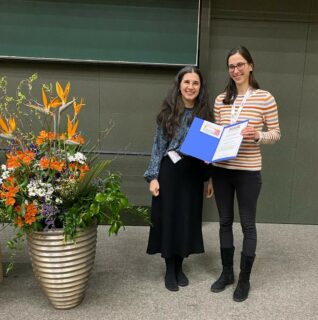DGAUM Presentation Prize 2024
As part of the 64th Annual Scientific Conference for the German Society of Occupational and Environmental Medicine (Deutsche Gesellschaft für Arbeitsmedizin und Umweltmedizin, DGAUM), Dr. med. Anna Wolfschmidt-Fietkau received the prize for best presentation for the topic “Biomonitoring and Biomarkers”. The prize was awarded for her presentation titled “Hydrofluoric-acid exposure in a human-skin ex-vivo model – Evaluation of various decontamination strategies and implications for first-aid measures in practice”.
Hydrofluoric acid (aqueous solution of hydrogen fluoride, HF) is used in many industrial branches (e.g. semiconductor technology, automobile manufacture). Dermal exposure from workplace accidents can lead to local burns as well life-threatening systemic reactions due to the absorption of fluoride into the body. The goal of first-aid measures is therefore to minimise HF transfer into the skin.
In an ex-vivo model, penetration experiments were performed on freshly excised, viable human skin. To this end, static diffusion cells, developed according to Franz (1975), were used. The donor and acceptor chambers of the diffusion cells are thereby separated from one another by prepared human-skin samples (0.64 cm2, thickness of 0.9 mm). In the donor chamber, hydrofluoric acid is applied to the skin (epidermal side). The amount of penetrated fluoride can be determined by taking samples from the receptor solution in the acceptor chamber at defined points in time. The effects of various exposure durations and decontamination strategies were compared.
The following factors were found to influence HF absorption and, in turn, systemic fluoride absorption:
- Time at which decontamination began: The earliest possible start was a more decisive factor in determining penetrated fluoride amounts than the selection of a certain decontamination agent.
- Skin temperature: A reduction of skin temperature from 32°C to 24°C significantly reduced the amount of penetrated fluoride.
- Selection of decontamination agents: Cleaning with PEG 400 proved to be the least effective regarding penetrated fluoride amounts. The user of water vs. calcium gluconate vs. Hexafluorine® as decontamination agents did not lead to any significant differences in fluoride absorption. The addition of acid-buffering substances to decontamination agents improved efficiency.
In cases of accidents with dermal hydrofluoric-acid contamination, the most decisive first-aid measure is to clean the affected area of skin as quickly as possible. All other measures – even the selection of the decontamination agent to be used – are of subordinate importance. Cooling and acid-buffering decontamination agents may additionally reduce the absorbed amount of fluoride.
Reference: Franz TJ (1975) Percutaneous absorption. On the relevance of in vitro data. J Invest Dermatol 64(3): 190–195. doi: 10.1111/1523-1747.ep12533356
